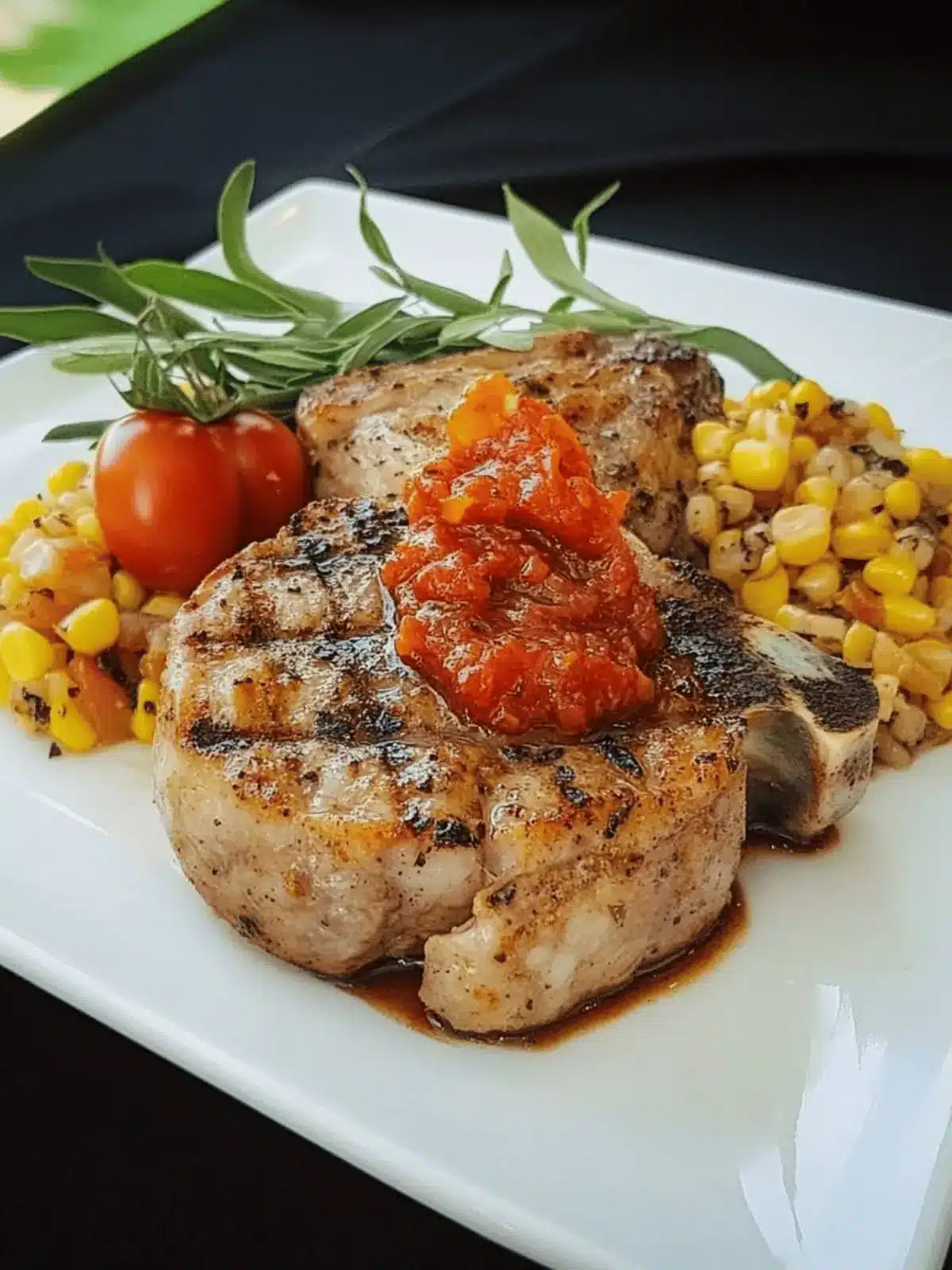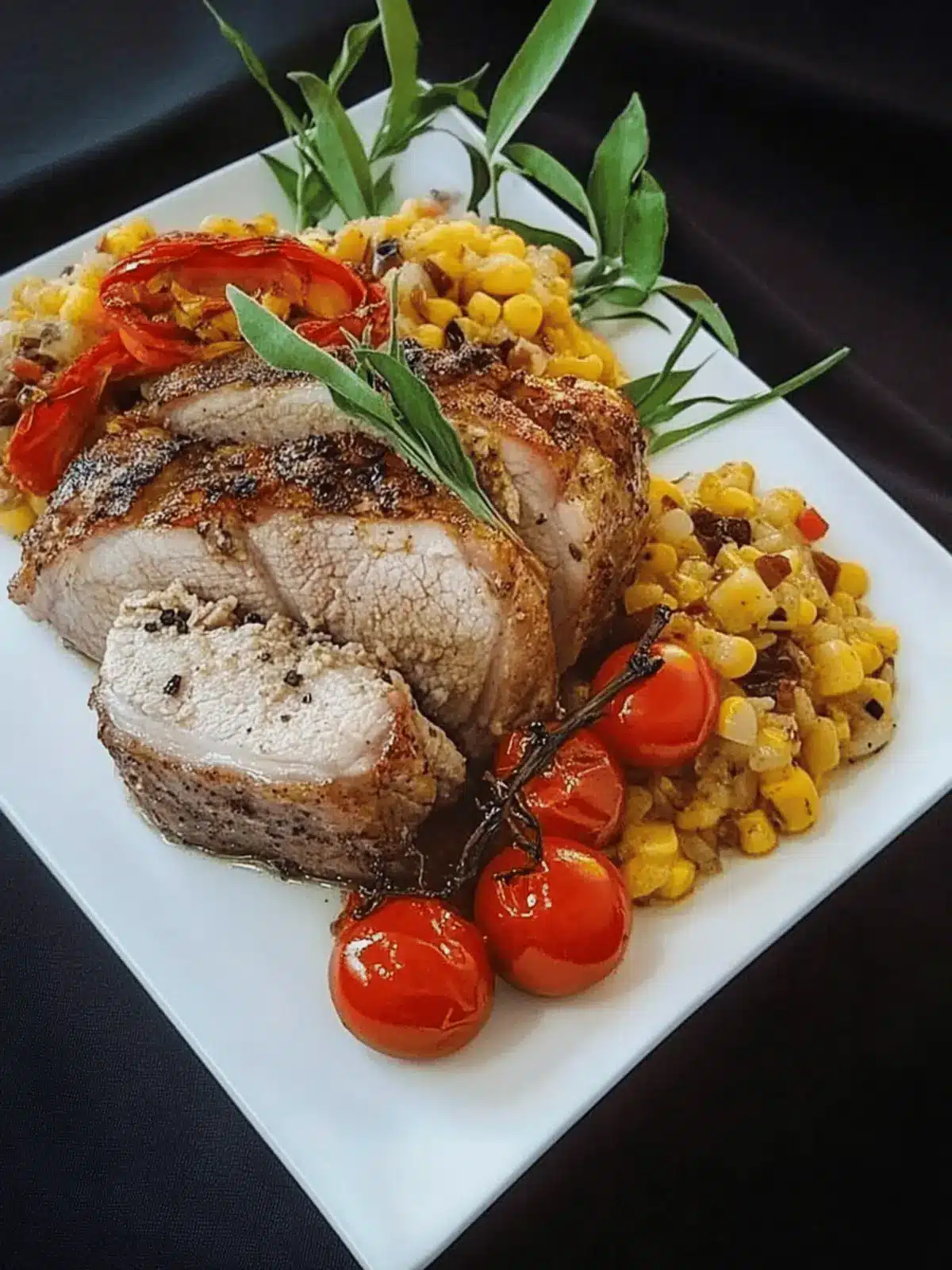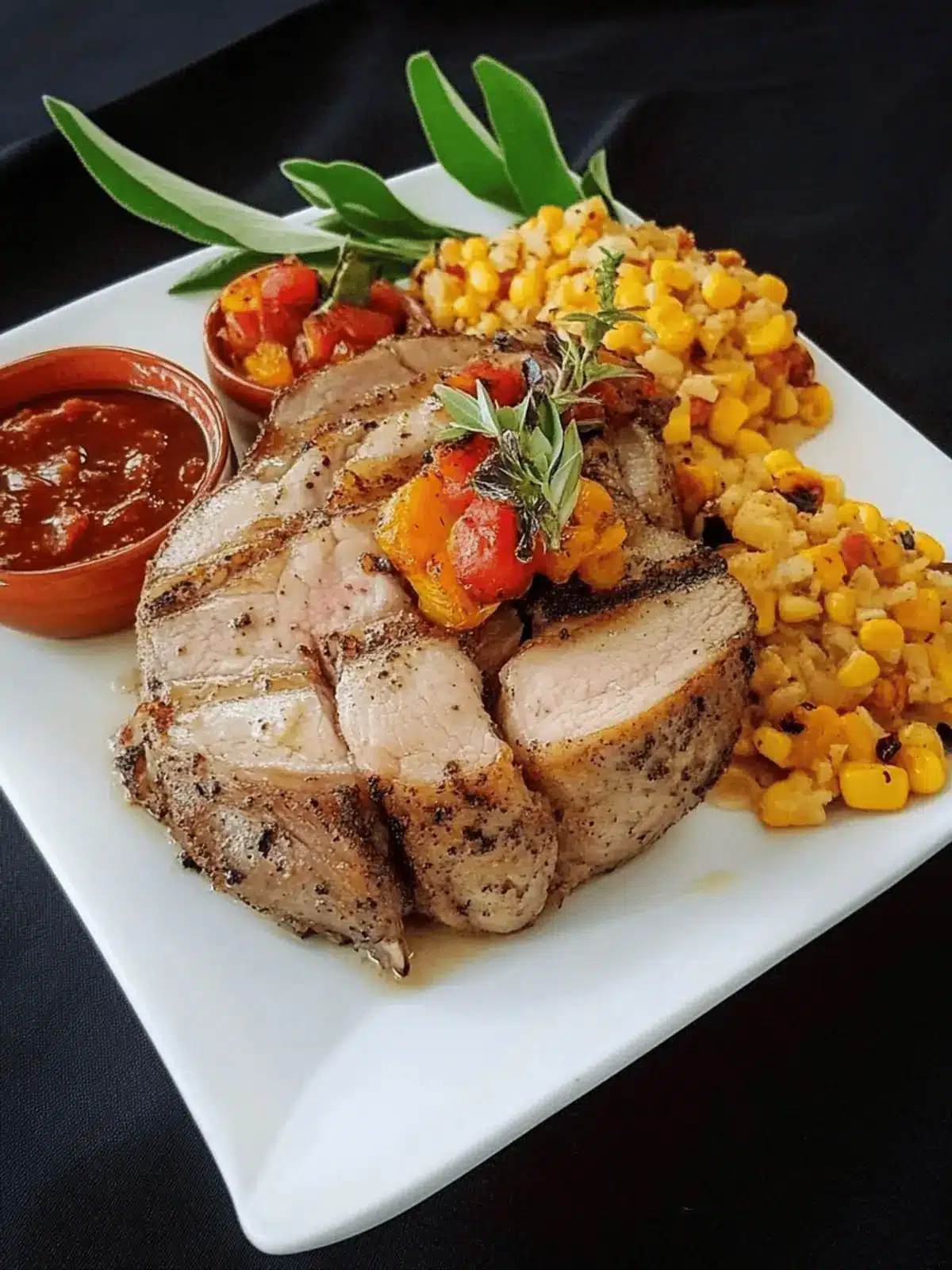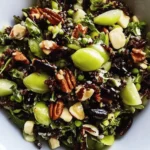When the evening sun casts a warm glow, there’s nothing quite like gathering around the table with family and friends, sharing stories and laughter over a sumptuous meal. One dish that consistently elevates such moments is the exquisite Pueblo Pork Roast. Inspired by the rich culinary traditions of the Pueblo natives, this roast melds the aromatic essence of juniper berries with a surprising hint of chocolate, reminiscent of traditional mole sauce.
Imagine a plate filled with tender, juicy pork that practically melts in your mouth, all cloaked in a velvety, dark sauce that invites you to savor every bite. Whether you’re looking to break free from the mundane fast-food routine or impress your loved ones with a crowd-pleasing main course, this recipe is sure to become a favorite. So, roll up your sleeves and let’s embark on a culinary adventure that pays homage to Southwest indigenous cuisine!
Why is Pueblo Pork Roast a Must-Try?
Unforgettable flavor profile: The unique combination of juniper berries and chocolate creates a depth of taste unlike any other roast you’ve tried.
Hearty and satisfying: Perfect for family dinners or social gatherings, this dish is a guaranteed crowd-pleaser.
Easy to make: Despite its gourmet appearance, the recipe is approachable, allowing even novice cooks to impress their friends and family.
Versatile options: Feel free to swap out the pork for chicken or adjust the spices to match your heat preference for a personalized touch.
Make-ahead friendly: Prepare this delight a day prior for enhanced flavors, allowing you more time to enjoy your company.
This is the perfect dish to break free from fast food monotony and celebrate real, homemade cooking.
Pueblo Pork Roast Ingredients
For the Sauce
• Vegetable Oil – Ideal for sautéing onions and garlic; can use canola oil for a neutral taste.
• Medium Onion – Adds sweetness and depth to the sauce; shallots can substitute for a milder flavor.
• Garlic Cloves – Infuses aromatic richness; adjust the quantity based on your preference.
• Juniper Berries – Offers a distinct piney flavor; rosemary can be a close substitute.
• Coriander Seeds – Contributes refreshing citrus notes; ground coriander is a convenient alternative.
• Bay Leaf – Enhances the sauce’s aroma; don’t forget to remove before serving to avoid bitterness.
• Tomatoes – Provides freshness and acidity; canned tomatoes work well if fresh ones aren’t available.
• Water – Thins out the sauce; no substitutions needed.
• Cider Vinegar – Balances the flavors with acidity; white wine vinegar or lemon juice are good alternatives.
• Honey – Adds a touch of sweetness and complexity; substitute with brown sugar if necessary.
• Chili Powder – Introduces warmth and spice; for a milder taste, use paprika instead.
• Salt – Enhances overall flavor; adjust according to personal taste.
• Unsweetened Chocolate – Deepens the sauce’s richness, reminiscent of mole; you can use dark cocoa powder as a substitute if needed.
For the Roast
• Pork Rib Roast – The star protein of this recipe; consider a bone-in pork shoulder for a similar result.
This is the essential list for creating a succulent Pueblo Pork Roast that celebrates the rich flavors of indigenous cuisine!
How to Make Pueblo Pork Roast
-
Heat oil: Pour vegetable oil into a sauté pan and warm over medium-high heat. Sauté diced onions and minced garlic until they soften and become fragrant, about 5 minutes.
-
Grind spices: In a spice grinder, process juniper berries and coriander seeds until finely ground. Add this aromatic blend to the pan along with the bay leaf, stirring to combine.
-
Simmer sauce: Mix diced tomatoes, water, cider vinegar, honey, chili powder, and salt into the pan. Cover and simmer on medium-low for about 30 minutes, allowing the flavors to meld beautifully.
-
Add chocolate: Stir in grated unsweetened chocolate and let it continue simmering for another 30 minutes. Cool the sauce slightly before puréeing it with an immersion blender until smooth.
-
Prepare oven: Preheat your oven to 325°F (160°C) and transfer the pork rib roast to a baking dish. Pour 3/4 of the sauce over the roast, letting it soak in.
-
Start baking: Bake the roast for 45 minutes, then baste with the remaining sauce. Return it to the oven for an additional 45 minutes, ensuring it cooks evenly.
-
Check doneness: Use a meat thermometer to check the internal temperature, reaching 150°F (65°C) at the thickest part. Let the roast rest for 15 minutes before slicing to retain its juices.
Optional: Serve with warm tortillas or crusty bread to soak up the delicious sauce.
Exact quantities are listed in the recipe card below.
Make Ahead Options
Preparing the Pueblo Pork Roast ahead of time is a game-changer for busy weeknights! You can make the mole sauce up to 3 days in advance; simply store it in an airtight container in the refrigerator. To maintain its rich flavors and velvety texture, be sure to cool the sauce completely before covering it. Additionally, the pork can be seasoned and left to marinate overnight for extra flavor infusion. When you’re ready to serve, transfer the sauce to a saucepan to reheat gently while preheating your oven to 325°F (160°C). Pour the warmed sauce over the marinated pork rib roast and bake as directed for a delicious, convenient meal that’s just as flavorful as when made fresh!
Pueblo Pork Roast Variations & Substitutions
Feel free to explore these delightful options that can add your personal touch to this recipe!
- Chicken Swap: Use skin-on chicken for a lighter, equally delicious dish that keeps the rich flavors intact.
- Spicy Kick: Add cayenne pepper or fresh jalapeños to the sauce for those who enjoy an extra layer of heat.
- Herb Infusion: Stir in fresh herbs like cilantro or thyme at the end of cooking to brighten the flavors and add complexity.
- Vegetarian Delight: Substitute the pork with hearty vegetables like eggplant or mushrooms, and increase the sauce’s richness for a vegetarian version.
- Smoky Flavor: Incorporate smoked paprika instead of chili powder for an added depth of flavor that echoes traditional barbecue.
- Fruity Twist: Add diced apples or pears to the sauce while simmering for a subtle sweetness that complements the pork beautifully.
- Different Chocolate: Substitute unsweetened chocolate with dark cocoa powder for a nuanced chocolatey richness that enhances the sauce.
- Citrus Zest: Grate some lime or orange zest into the sauce just before serving to elevate the dish with a fresh and zesty contrast.
How to Store and Freeze Pueblo Pork Roast
Fridge: Store leftover Pueblo Pork Roast in an airtight container for up to 3 days. Make sure to keep the sauce separate to maintain moisture and flavor.
Freezer: To freeze, wrap the pork roast tightly in plastic wrap and place it in a freezer-safe bag. It can last for up to 3 months. To reheat, thaw in the fridge overnight and reheat gently in the oven.
Reheating: When ready to serve, preheat the oven to 350°F (175°C). Place the roast in a baking dish, cover it with foil, and reheat for about 25-30 minutes, basting with leftover sauce for added moisture.
Make-Ahead Tip: This dish is perfect for making ahead of time, allowing the flavors to develop further when stored in the fridge for up to a day before serving.
What to Serve with Pueblo Pork Roast?
When you’re ready to gather loved ones around the table, pairing this savory roast with complementary dishes transforms a meal into a feast.
- Warm Tortillas: Soft, warm tortillas are perfect for wrapping around tender slices of pork, soaking in the rich flavors of the chocolate mole sauce.
- Arugula Salad: A fresh arugula salad with a light citronette adds a peppery and tangy contrast to the roast’s richness, elevating the entire meal.
- Creamy Polenta: This creamy, buttery polenta creates a delicious base that balances the bold flavors of the roast while ensuring each bite is satisfying.
- Roasted Vegetables: Colorful roasted seasonal vegetables bring a sweet, caramelized crunch that harmonizes beautifully with the savory pork and deep sauce.
Pairing these sides creates a medley of flavors and textures, allowing the Pueblo Pork Roast to shine while ensuring every bite is a delightful experience.
- Chilled White Wine: A glass of chilled Sauvignon Blanc or a crisp Verdejo complements the savory notes and balances the richness of the dish wonderfully.
- Chocolate Mousse: For dessert, a light chocolate mousse echoes the chocolate in the mole while providing a sweet finish to such a hearty dish.
Expert Tips for Pueblo Pork Roast
-
Cool Sauce First: Allow the sauce to cool before blending. This ensures the best texture and prevents any messy splatter during puréeing.
-
Check Temperature: Always use a meat thermometer to confirm the pork roast reaches an internal temperature of 150°F (65°C) for safe consumption.
-
Resting Is Key: Let the roast rest for 15 minutes after removing it from the oven. This step is essential for juicy, tender slices of your Pueblo Pork Roast.
-
Baste for Flavor: Basting the pork with the reserved sauce not only adds flavor but helps keep the meat moist during the baking process.
-
Adjust Spice Level: If you enjoy some heat, feel free to tweak the chili powder or add jalapeños to the sauce for an extra kick.
-
Make-Ahead Magic: Prepare your Pueblo Pork Roast a day in advance to enhance the flavors, making family dinners even more enjoyable!
Pueblo Pork Roast Recipe FAQs
What type of pork is best for Pueblo Pork Roast?
Absolutely! A pork rib roast is ideal for this recipe due to its tenderness and flavor, but you can also use a bone-in pork shoulder for a similar result. The fat content in these cuts helps keep the meat juicy during cooking.
How should I store leftover Pueblo Pork Roast?
To store leftovers, simply place the Pueblo Pork Roast in an airtight container, making sure to keep the sauce separate to maintain moisture and flavor. It will stay fresh in the fridge for up to 3 days.
Can I freeze Pueblo Pork Roast?
Very! To freeze, first, wrap the pork roast tightly in plastic wrap, then place it in a freezer-safe bag. It can be stored for up to 3 months. When you’re ready to enjoy it again, simply thaw it overnight in the fridge before reheating.
How do I reheat the Pueblo Pork Roast?
Reheating is straightforward! Preheat your oven to 350°F (175°C), place the roast in a baking dish, cover it with foil, and heat for about 25-30 minutes. Basting with the leftover sauce adds moisture and keeps it tasty.
What if I can’t find juniper berries?
No worries! You can substitute juniper berries with rosemary for a similar piney flavor, though the taste won’t be identical. Just adjust according to your preference; the more the merrier when it comes to experimenting!
Are there any dietary considerations for this recipe?
If you’re considering allergies, keep in mind that this recipe contains common allergens like garlic and honey. For those cooking for pets, keep the chocolate out of their reach as it’s toxic to them. Always check for sensitive ingredients when cooking for a crowd.
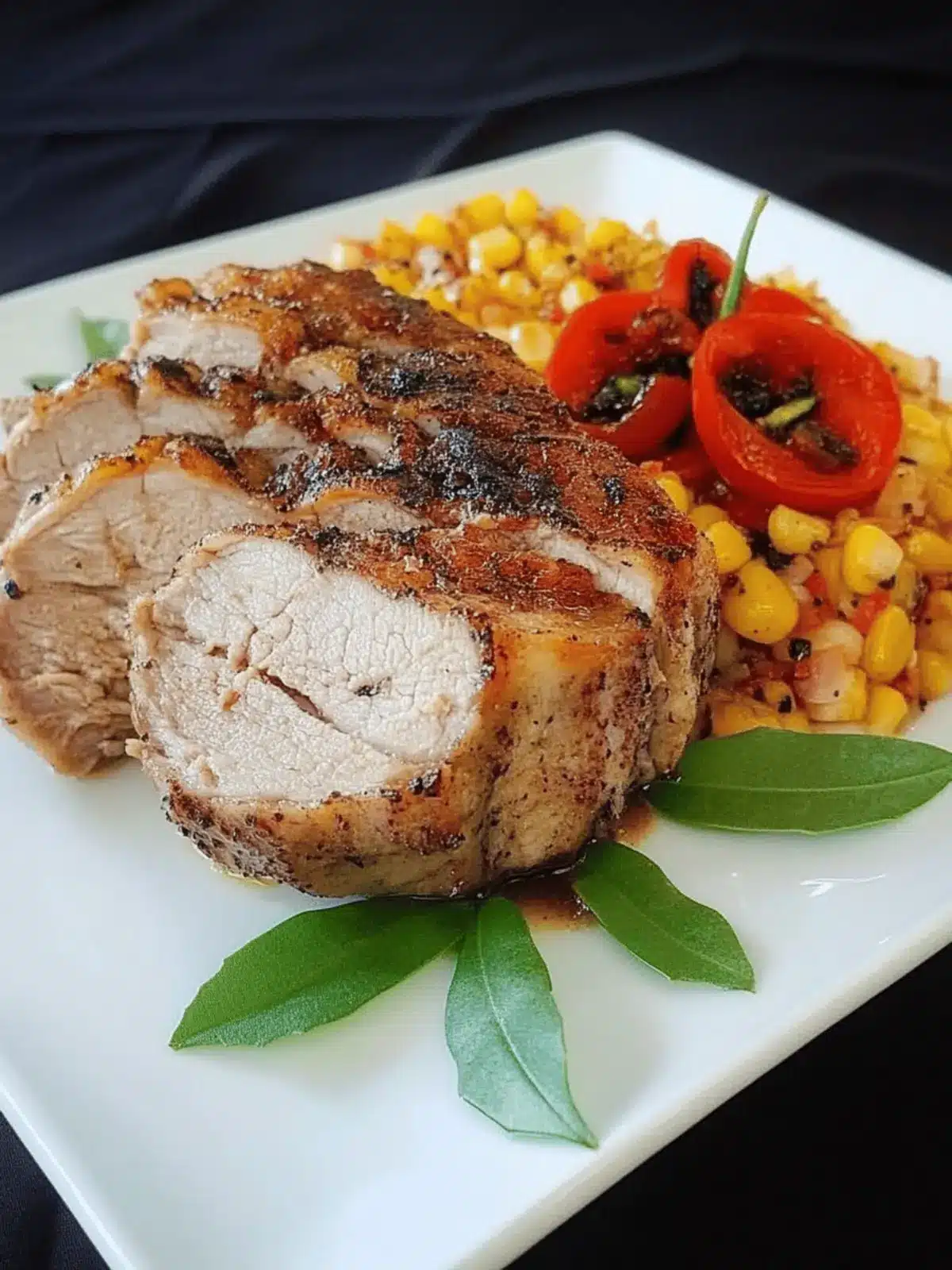
Savory Pueblo Pork Roast with Rich Chocolate Mole Sauce
Ingredients
Equipment
Method
- Pour vegetable oil into a sauté pan and warm over medium-high heat. Sauté diced onions and minced garlic until they soften and become fragrant, about 5 minutes.
- In a spice grinder, process juniper berries and coriander seeds until finely ground. Add this aromatic blend to the pan along with the bay leaf, stirring to combine.
- Mix diced tomatoes, water, cider vinegar, honey, chili powder, and salt into the pan. Cover and simmer on medium-low for about 30 minutes.
- Stir in grated unsweetened chocolate and continue simmering for another 30 minutes. Cool the sauce slightly before puréeing it with an immersion blender until smooth.
- Preheat your oven to 325°F (160°C) and transfer the pork rib roast to a baking dish. Pour 3/4 of the sauce over the roast, letting it soak in.
- Bake the roast for 45 minutes, then baste with the remaining sauce. Return it to the oven for another 45 minutes.
- Use a meat thermometer to check the internal temperature, reaching 150°F (65°C). Let the roast rest for 15 minutes before slicing.

